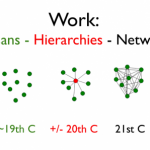In Advice for the Training Department I recommended that those in the training function should concentrate on Communicating & Connecting. Later I suggested that the training department should wake up and smell the coffee or be rendered obsolete. All of this is premised on the fact that our organisational structures need to change in order to deal with complexity and one framework we can start with is wirearchy.
However, the training department can at best manage incremental change unless the organisation itself changes. In It’s Time to Invert the Management Pyramid, Vineet Nayer says:
It is not a stationary relic I’m talking about. I’m talking about the brand new dinosaur on the block – the classical management pyramid. Time has come to dismantle it and adapt to a new evolutionary and unstructured model that leverages the team effect to ensure that companies can lead change rather play catch up or be left behind.
The training department and the CLO can help in this effort, but inverting the pyramid is the big work that needs to be done by the entire organisation.
I believe that structural change is coming sooner than many expect, with the WorldBlu list as an example of the hunger for change. The inability of our prominent command and control organisations to deal with growing complexity highlights our structural problems. The largest military force in the world cannot defeat a loosely knit group of terrorists; the US/Cdn automotive sector has been incapable of changing its business model and our elect & forget political representatives are increasingly hamstrung by an electorate that no longer provides majorities or landslides.
It is time to invert the pyramid and integrate learning into all that we do. Are you ready?



My uncle and I were running traing programmes in the late 80’s and early 90s using the inverted org chart. The more senior you are, the heavier the load you carry.
Thanks Harold for the mention, love what you’re doing and love the diagram too! Very helpful to see how this all works in a simple yet powerful visual. We hope to help grow the sea-change for organizational democracy in the world in a massive way. Now is the time with the break-down of the old command and control model so evident. It’s time for the new, democratic model to emerge and be embraced.
Thanks again for blogging about these very important issues.
Warmly,
Traci Fenton
WorldBlu
Keep up the good work at WorldBlu, Traci.
What Karen said … See Tom Peters. circa 1990 or so …
It’s the case (IMO) that doing this stuff for real sharpens the game for enlightened and listening-focused leadership.
And no best practices from external consultants and “gurus”!
But this is an interesting model which can really help people understand the need and place for PSS solutions.
Best practices do not remain best practices forever, they evolve (on the shop floors) rather than change non-linearly (getting a new consultant).
Perhaps no “out of the box” best practices from external consultants (e.g. Six Sigma; Lean), but an external consultant can be a fresh pair of eyes to see problems that are overlooked within the organisation, IMHO ;-)